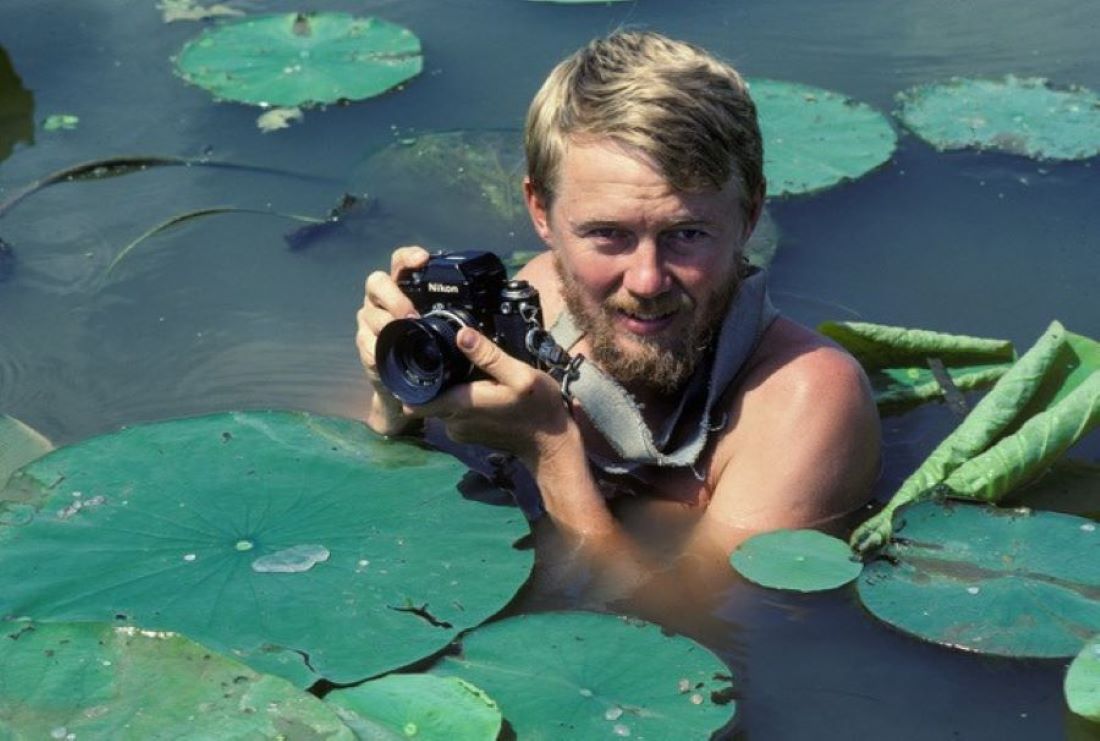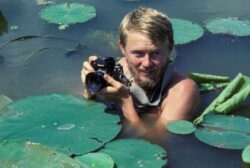C. C. Lockwood
For more than half a century, photographer C. C. Lockwood has documented Louisiana’s natural features, landscapes, flora, and fauna.

C. C. Lockwood
C. C. Lockwood photographing fragrant water lilies in the Atchafalaya Basin for his 1984 book on the Gulf Coast.
Since photography’s introduction in Louisiana in 1840, few have been associated with the medium’s depictions of the state’s natural features, landscapes, flora, and fauna, more than C. C. Lockwood. For more than half a century, Lockwood has explored the state’s remote areas, permitting viewers to engage with the plant and animal life of his adopted state. The approximately 1.5 million acres of the Atchafalaya River basin is a favorite location and source of inspiration. While some striking pictures attract attention and induce marvel at Lockwood’s abilities, the photographer’s greater message is that all parts of Louisiana’s living and complex landscapes are interdependent, balanced, and, if not properly managed, precarious.
Early Life and Education
Lockwood was born in Kansas City, Missouri, in 1949 to Spring and Frank Lockwood. His father’s career as a doctor with the US military prompted the family to move to Fort Smith, Arkansas, when Lockwood was a year old. There, in the third grade, a simple box camera launched his interest in photography. Lockwood continued making photographs, and in high school, he obtained a more advanced camera, but still a relatively simple one. He remained in Fort Smith until he turned eighteen.
From Fort Smith he traveled to Baton Rouge to enroll at Louisiana State University. His first academic pursuit was architecture, but he later switched to a major in business. While working for the student newspaper the Reveille, Lockwood honed his photography skills through varied day-to-day assignments and acquired a professional-grade, single-lens reflex camera. However, when he graduated in 1971, Lockwood initially pursued a career in accounting.
Pursuit of Photography
The summer after graduation Lockwood went to Yellowstone National Park in Wyoming to assist a friend who was making a documentary film about the area’s big horn sheep. While working on the project, he met professional wildlife photographer Leonard Lee Rue. The encounter showed Lockwood that nature photography could be a career, not just an interest, and he changed his direction accordingly. Feeling a need to learn more darkroom techniques, he enrolled in the photography master’s program at East Texas State University for a semester in the spring of 1972. His purpose was to acquire additional knowledge of camera operations and photographic materials but not to pursue a degree. In time Lockwood’s work was published in books and numerous magazines, with a significant assignment from National Geographic on the Atchafalaya Basin published in September 1979. Other periodicals that published his work include American Photographer, Audubon, National Wildlife, and Smithsonian.
Mature Career
The Atchafalaya Basin soon became a leitmotif in Lockwood’s career. Though his fourteen books cover subjects ranging from the Yucatán Peninsula to the Grand Canyon, the Atchafalaya (the subject of three books and a documentary film) remains his touchstone. Other publications that embrace a larger geographic area are still heavily illustrated with Lockwood’s Atchafalaya photographs (e.g., The Alligator Book, Still Waters, Discovering Louisiana, and Marsh Mission). In most of his books, Lockwood writes the accompanying text, ranging from brief to extensive. The text not only describes particular circumstances about selected photographs but also explains why the wild nature of the Atchafalaya is an important part of a healthy ecosystem that stretches far beyond its Louisiana location.
Lockwood’s photographs are rarely taken from the roadside, as he learned that driving the ring road of the Atchafalaya Basin offered few photographic revelations. Consequently he has flown over, hiked, paddled, waded, and boated to the inner reaches of the basin to capture scenes of the area, the creatures that inhabit it and their behaviors, and the implicit question of what may be lost under pressure from commercial and industrial development, overharvesting of natural resources, and other forms of intrusion. Though Lockwood’s photographs emphasize nature and landscape in the Atchafalaya, he documents the seasonal activities of the few individuals who make their living there by fishing, hunting, trapping, logging, and serving as guides to the area.
In 1997 the Baton Rouge Morning Advocate commissioned Lockwood to write and post a daily five-hundred-word illustrated online article as he descended the Mississippi River on a raft. The project lasted two months and, with a digital camera and laptop computer provided by the newspaper, introduced Lockwood to digital photography and online publishing. Initially he used the relatively new imaging technology of digital photography for this single purpose. His early years as a nature photographer often saw him travel with hundreds of rolls of color film, and except for the weekly online article, he continued using film for the rest of his photography until 2008, when he exclusively adopted digital photography. According to Lockwood the transition to digital photography makes access to some species (alligators and bald eagles, for example) easier. It also permits him to travel lighter when in more remote areas of the landscape.
Legacy
Lockwood has many accomplishments as a photographer, writer, and conservation champion. Awards for his books, photography, and service to conservation causes highlight notable achievements and honors. Lockwood helped found the Baton Rouge Audubon Society in 1974 and received the Sierra Club’s Ansel Adams Award for conservation photography in 1978. Louisiana Public Broadcasting named him a Louisiana Legend in 2000, and in 2005 the Louisiana Wildlife Federation honored him as Conservation Communicator of the Year. His 1976 documentary film, Atchafalaya, America’s Largest River Basin Swamp, took first place in that year’s San Francisco International Film Festival category for natural history and environment. Despite this personal recognition, Lockwood would rather be remembered as one who influenced a younger generation of photographers through his books and photographic workshops. He sees those who use his work as a model to celebrate and champion their own visions of Louisiana’s natural environment as his greatest legacy.
